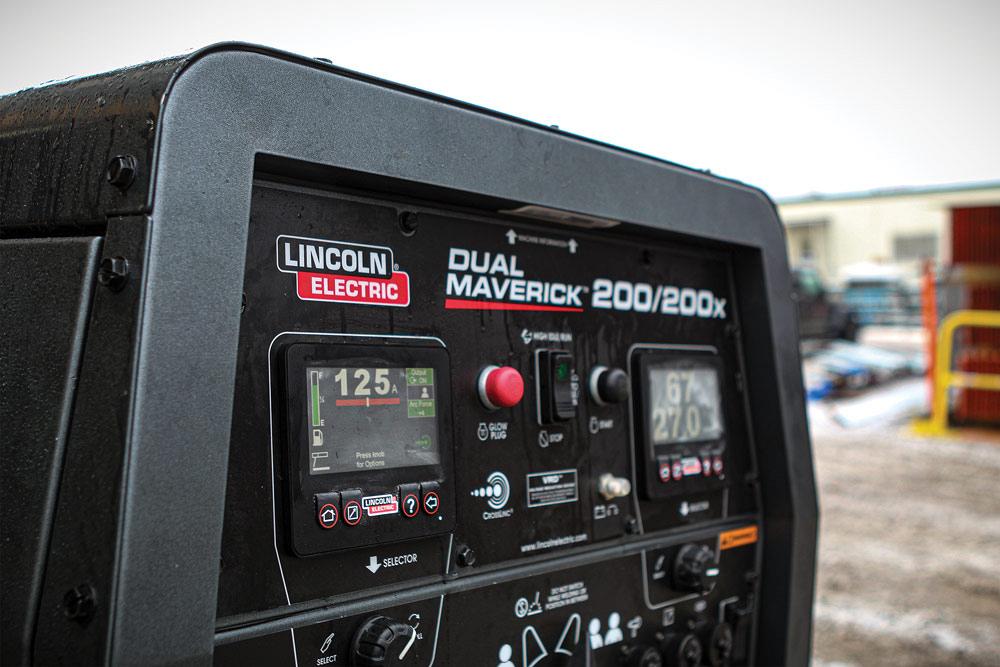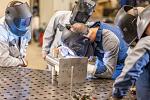Editor
- FMA
- The Fabricator
- FABTECH
- Canadian Metalworking
Technology Spotlight: Mobile welding gets tech savvy
How mobile welder/generator upgrades aim for operator and equipment efficiencies
- By Rob Colman
- June 17, 2021
Mobile welding equipment is, of necessity, ruggedly built for work on building sites, pipelines, and other outdoor applications. Technology upgrades are now adding tools that help keep welders longer at the arc, while also helping them manage power consumption and maintenance schedules. Lincoln Electric’s made-in-Canada Maverick series provides a good example of how these technologies are being integrated into mobile welder/generators.
Controls in Hand
One of the most advantageous advancements in the past few years on many welder/generators is operators’ ability to make adjustments to their weld settings at the arc instead of having to walk back to the machine. In a shop setting, this might not be a major benefit, but if a welder is hundreds of feet away from a machine, three or four floors up, adjustments can be more than a little difficult.
“Obviously, one of the biggest concerns on job sites is time wasted walking to and from machines to make adjustments, or relaying down through a helper for the needed adjustments,” said Nick Winarski, product manager, industrial engine drives, The Lincoln Electric Company. “But there is also a safety value in this type of technology. Decreasing any extra movement on a job site helps to reduce the possibility of slips and trips.
“Additionally, having the controls at hand makes it more likely that an operator will finely tune their weld settings,” he continued. “At some point, if an operator is walking back and forth to his controls, he’s likely to say, ‘This is good enough.’ Quality on welds is inevitably going to improve with better control.”
Lincoln Electric’s newest Maverick, Vantage, and Ranger models are equipped with its CrossLinc-branded version of this technology.
Clearer Controls
The machines themselves are being made more intuitive to adjust with the addition of digital displays.
“This is by no means new technology in general, but we finally have digital displays that are robust enough to handle rugged environments,” said Al Nystrom, product manager, industrial equipment, Lincoln Electric. “We can put full text on the machine’s display to help guide users with machine operation and control. Maintenance reminders can be provided on the screen also. When a certain component needs replacing, a reminder is provided.”
Machines also can be equipped with an added PIN to lock out the machine when operators are not on-site so that the generator doesn’t get used by other tradespeople or unauthorized personnel.

Mobile welding machines are being made more intuitive to adjust with the addition of digital displays.
Idling Management
Another new technology added to some welder/generators is a stop/start feature that reduces excessive idling. These machines are equipped with timers that monitor if a weld is being output from the unit, and if there isn’t any after a certain amount of time, the machine goes to a standby state. The minute the operator touches his stick electrode to the workpiece, the engine fires back up again. If the operator is called away for an extended time, the machine shuts down fully, saving the battery life.
“There is a lot of excess idling of machines on job sites,” said Winarski. “Sometimes an operator will turn on his machine at the start of a shift and leave it running all day. On that shift, it might use auxiliary power for two to three hours.”
“There is often not much the operator can do about the amount of idle time,” said Nystrom. “Some work requires an extensive amount of prep work, during which the equipment has to sit there idle.”
But Nystrom points out that it’s not just fuel savings that the start/stop technology assists with, it’s also maintenance.
“A lot of larger contractors are insisting the technology be used on their machines because it saves on maintenance costs as well,” he said. “The maintenance on these machines is based on how many hours they run, so no matter how much welding is done with a machine once its engine has been running for a certain number of hours, it needs to receive routine maintenance. If you’re running 10 hours a day, you could easily end up taking it in for maintenance once a month. Using start/stop technology, it might be that you end up taking it in for maintenance much less over the course of a year.”
Machine Tracking
Welding machines can also help companies who want to use the power of big data to improve their business. Winarski and Nystrom noted that their customers are now asking them for telematics – data that tracks location, hours, and other information that allows them to gather important maintenance information via a dashboard.
Operators can also get useful feedback at the machine.
“One thing we’ve added to the displays on the machines themselves is a simple productivity matrix so that the operator can open the screen and see his arc-on hours, auxiliary hours, and a simple formula to show the use of the machine – when it was idling and when it was actually running,” said Winarski. “This allows operators to see how much less time the machine was running using the auto stop/start compared to how long it would previously have run.”
Noise Management
Although not something operators or owners generally ask for, Lincoln Electric has been working to make its welder/generators quieter as well.
“It’s not something customers asked for, but once they hear how much quieter the machines are, they are happy,” said Winarski. “Applications in a city environment need to be a little quieter, and these new machines are sound- deadened in a way that really helps with that. Further, not shouting over the noise of machines makes it easier to talk to staff as well.”
More uptime on the machine, less movement on the job site – it all adds up to a potentially safer, more productive operation. The addition of telematics and start/stop technology means that productivity can be extended to maintenance protocols too.
Editor Robert Colman can be reached at rcolman@canadianfabweld.com.
Lincoln Electric, www.lincolnelectric.com
subscribe now


Keep up to date with the latest news, events, and technology for all things metal from our pair of monthly magazines written specifically for Canadian manufacturers!
Start Your Free SubscriptionAbout the Author

Rob Colman
1154 Warden Avenue
Toronto, M1R 0A1 Canada
905-235-0471
Robert Colman has worked as a writer and editor for more than 25 years, covering the needs of a variety of trades. He has been dedicated to the metalworking industry for the past 13 years, serving as editor for Metalworking Production & Purchasing (MP&P) and, since January 2016, the editor of Canadian Fabricating & Welding. He graduated with a B.A. degree from McGill University and a Master’s degree from UBC.
- Trending Articles
Class is in session for college connections

BlueForge Alliance partners with Nuts, Bolts & Thingamajigs to develop Submarine Manufacturing Camps

Portable system becomes hot tech in heat treatment

Orbital tube welding webinar to be held April 23

Cidan Machinery Metal Expo 2024 to be held in Georgia May 1-2

- Industry Events
MME Winnipeg
- April 30, 2024
- Winnipeg, ON Canada
CTMA Economic Uncertainty: Helping You Navigate Windsor Seminar
- April 30, 2024
- Windsor, ON Canada
CTMA Economic Uncertainty: Helping You Navigate Kitchener Seminar
- May 2, 2024
- Kitchener, ON Canada
Automate 2024
- May 6 - 9, 2024
- Chicago, IL
ANCA Open House
- May 7 - 8, 2024
- Wixom, MI
















